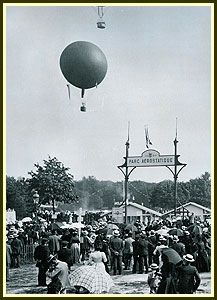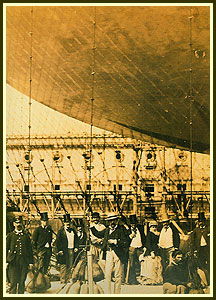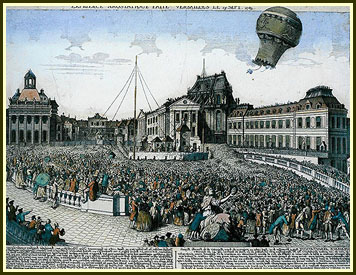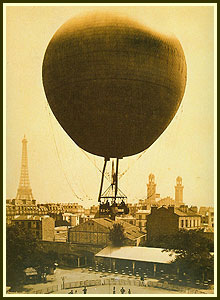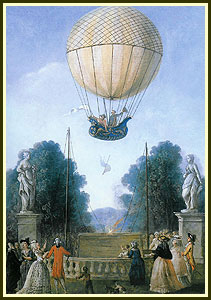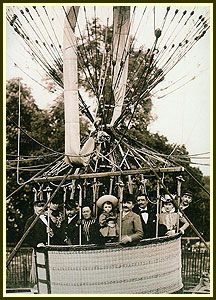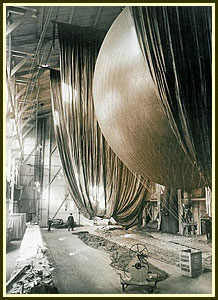

At the turn of the 20th century people had the chance to experience the magic of ballooning from the gondolas of tethered gas balloons. 100 years later people can once again capture the magic of ballooning in these modern marvels called Aerophiles.Please join us as we take a look back at some of the highlights and history of ballooning.
Pumped full of poetry and magic, the balloon has been an object of fascination for more than two centuries. The exploits of lighter than air vessels have left their mark in the anals of time.
Enthusiastic crowds cheered the lift off of the first balloons toward the end of the 18th century. During the second half of the 19th century and the beginning of the 20th century, people have the chance to experience the magic of ballooning from the gondolas of tethered balloons.
1776 An Englishman, Henry Cavendish, using a combination of sulfuric acid and iron, discovers hydrogen.
1783 Jaçques Charles launches The Globe, an unmanned hydrogen balloon, which traveled 15 miles and reached an altitude of 3000 feet. The balloon landed in Gonesse where the locals attacked the balloon with pitchforks, destroying it.
September 19th, 1783 A sheep, a duck and a rooster become the first passengers in a hot air balloon. The Montgolfier brothers, Jaçques Etienne and Joseph Michel, launched a balloon made of paper and cloth after Louis XVI had decreed that the first flight should be flown with animals. The balloon rose to about 6000 feet, and landed safely.
November 21st, 1783 The first recorded manned flight in a hot air balloon takes place in Paris. Built from paper and silk by the Montgolfier brothers, this balloon was piloted on a 22 minute flight by Jean François Pilâtre de Rozier and the Marquis François-Laurent d'Arlandes.
From the center of Paris they ascended 500 feet above the roof tops before eventually landing about 6 miles away in the vineyards. Local farmers were very suspicious of this fiery dragon descending from the sky. The pilots offered champagne to placate them and to celebrate the flight, a tradition carried on by balloonists to this day.
December 1st, 1783 The first manned gas balloon is launched by Jaçques Alexander Charles and Nicholas Louis Robert. Starting in Paris, the flight lasted 2 1/2 hours and covered a distance of 25 miles. Upon landing, Robert stepped out of the basket, which caused the balloon to rise again, this time to about 9000 feet. Charles later landed safely. Today, in France, gas balloons are known as Charliers and hot air balloons are known as Montgolfiers.
January 19th, 1784 In Lyon, France, the only recorded flight by Joseph Montgolfier is made in a balloon that had a cubic capacity of over 700,000 cubic feet. This would equate to a passenger capacity of around 30 people! It was one of the largest balloons ever made. The flight only lasted 20 minutes due to a rip in the fabric.
September 15th, 1784 An Italian, Vincenzo Lunardi, makes the first balloon flight in England. The 18,000 cubic foot balloon flew from the Artillery grounds at Moorfields and landed in Long Mead, near Ware. His passengers included a dog, a cat and a pigeon (in a cage).
November 30th, 1784 Launching their balloon from Rhedarium Garden, London, another Frenchman, Jean-Pierre Blanchard and an American, John Jeffries, make their first flight. On January 7th, 1785 the same team of Blanchard and Jeffries became the first to fly across the English Channel.
June 15th, 1785 The first casualties from ballooning occur when a hybrid gas/hot-air balloon piloted by Jean-François Pilâtre de Rozier and his passenger, one M. Romaine catches fire and explodes while attempting an English Channel crossing. Today, hybrid balloons (using a combination of gas and hot air lift) are known as "Roziers"
January 9th, 1793 The first flight of a balloon in America occurs in Philadelphia from the Walnut Street Prison Yard and is piloted by Jean Pierre Blanchard. Blanchard had also flown the first ascents in Germany, Holland, Belgium and Switzerland.
In the early 1800's American aeronauts, including Charles Durant, Thaddeus Lowe, John La Mountain, Rufus Wells and John Wise continue to design, construct and fly both gas and hot air balloons.
1804 Jaçques Garnerin celebrates Napoleon's coronation by launching an unmanned balloon, ablaze with lights from the city of Paris. Unfortunately, it crashed into a statue of Nero outside of Rome, which was considered a personal insult by Napoleon.
During this same time frame, Joseph Gay-Lussac flew to about 20,000 feet and recorded scientific observations of the atmosphere.
1861 Tethered gas balloons are used by both sides during the American Civil War for observation of troop movements. Balloons had been used for this purpose as early as 1794 in France.
1870-71 Balloons are used to carry refugees and mail out of Paris during the siege of that city by Prusso-German forces. One hundred people escape, along with over 2 million letters.
July, 1897 Swedish aeronaut Salomon Andree makes an attempt to reach the North Pole in a balloon named Eagle. A message sent by carrier pigeon on the third day was the only news. Thirty three years later, the remains of the crew were discovered by Norwegian explorers.
1906 James Gordon Bennett, a New York newspaper owner, sponsors a silver trophy for a long distance international balloon race. The first race started in Paris, and was won by an American, Frank Lahm, who landed after 22 hours in Yorkshire, England. By the terms of the race, the winner's country was the host for the next year's race, which was held in St. Louis in 1907. Twenty six races were held between 1906 and 1938, in six different nations. The race was revived in 1979 and continues today as the premier gas balloon race in the world.
1931 Auguste Piccard invents the airtight cabin, based on the bathysphere, enabling him and an assistant to ascend to 51,775 feet. In 1932 he flew to 53,152 feet to study cosmic rays.
October 3, 1934 Jeannette Piccard, pilots a balloon with her husband Jean (Auguste's twin brother) aboard to 57,579 feet for cosmic ray studies and lands safely.
November 11, 1935 A. W. Stephens and O. A. Anderson reach a height of over 74,000 feet in a huge (3.7 million cubic feet) helium balloon Explorer II. They launch from the "stratobowl" in South Dakota, later to be the scene of the first successful modern hot air balloon flight.
1947 Don Piccard, son of Jean and Jeannette Piccard, used a military surplus Japanese gas balloon for what was probably the first post-war free balloon flight, ushering in the modern era of ballooning. Mr. Piccard made his first balloon flight in 1933.
1961 Cdr Malcom Ross and Lcdr Victor Prather rise to 113,739.9 feet in a balloon called Lee Lewis Memorial.
1973 Adventures Out West purchases first balloon
1975 Balloon Federation of America started
Colorado Balloon club started
1978 Flight of the Double Eagle. First balloon flight across the Atlantic Ocean.
1982 First gas balloon flight over the continental divide. Aspen Colorado to points beyond
2000 First non stop flight around the world. Breitling Orbiter III
2004 Gigantica: first tethered gas balloon in Colorado.
© copyright 2004, GIGANTICA
